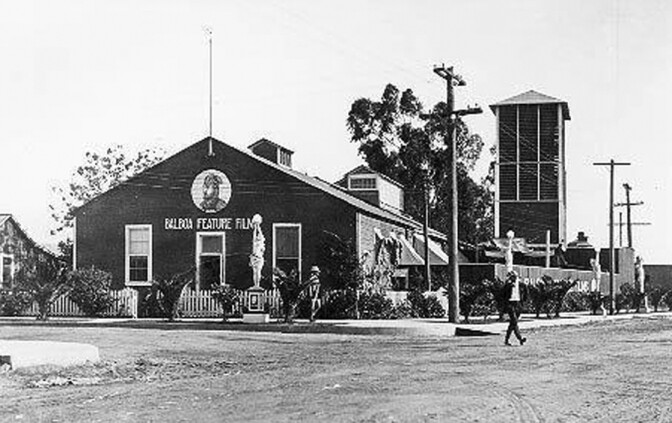The story Hollywood tells about itself begins in 1913 in a barn near the corner of Vine and Selma rented by Jesse Laskey and C. B. DeMille. They were New York movie makers in flight from goons sent by the Motion Picture Patents Company to confiscate equipment the company claimed was in violation of its patents. The barn was the first studio in Hollywood, and DeMille’s “The Squaw Man” (1914) was the first film made there.
But there’s an alternate history. It begins in Long Beach in 1910 at the corner of Sixth Street and Alamitos Avenue where a consortium of local businessmen, operating as the California Motion Picture Manufacturing Company, put up California’s first, purpose-built movie studio. Long Beach — a resort town known then for Methodist camp meetings — was the original West Coast movie capital. “On Matrimonial Seas,” filmed in April 1911, was its first production.
It featured Hampton Del Ruth and Irene Blakeney in a plot that, according to the Long Beach Daily Telegram, depicted “the troubles of Mr. and Mrs. Miss-Wed” whose romantic holiday at the beach is comically upended.
It’s difficult to know how many more 10-minute, one-reel films the CMPMC produced between 1910 and 1913 when the company sputtered to a halt and production ended. Most seem to have been unscripted scenes aimed at boosting Long Beach tourist attractions.
The Picture Beautiful
Herbert Horkheimer, along with his brother Elwood, purchased the vacant studio in October 1913 and announced that their Balboa Amusement Producing Company would expand production. They put Jackie Saunders and Ruth Roland under contract as leading ladies, recruited other performers (including actor-director Henry King) and began filming.
They stepped immediately into controversy. The Horkheimers believed they had an agreement to adapt Jack London’s adventure novels for the screen. London thought otherwise and sought an injunction to prevent filming. The litigation propelled London and other writers to lobby Congress successfully for legislation giving writers control over the use of their work in the new medium of motion pictures.
In its own origin story, Hollywood was founded by Jewish entrepreneurs, mostly immigrants from Eastern Europe, who had experience running nickelodeon theaters, which charged a modest five cents for admission. The Horkheimer brothers were from Wheeling, West Virginia and had never even seen a movie projector. But they had stage experience and the active support of Long Beach businessmen who saw filmmaking as a way to promote tourism and development. More importantly, Herbert Horkheimer had an unusually clear idea of how a studio should be organized to make film production as efficient as possible.
Success for Balboa was measured in thousands of feet of exposed film that could be packaged as 30- and 60-minute photoplays and 20-minute serial chapters. As many as eight production companies filmed at the studio and on location to meet the demand. Over time, four of Balboa’s production companies would be headed by women.
“One of our companies here in Long Beach,” Herbert Horkheimer told the Daily Telegram in 1914, “is now engaged in the making of six reels devoted to St. Elmo, the famous Southern novel written by Mrs. Augusta J. Evans. Recently another of the Balboa companies completed a four-reel photodrama, “A Will o the Wisp,” a production which had for many of its most important scenes the flooded district north of Long Beach. “The players in this story … risked their lives to enact their roles amid the vistas of moving waters and washed-out bridges and roads.” (Severe flooding affected all of southeast Los Angeles County in the winter of 1914-1915.)
Balboa, like other independent studios, released through exchanges and film distributors, both in this country and in Europe. Balboa worked through four major distributors: Pathé, the General Film Company, the Mutual Film Corporation and B. S. Moss Film Corporation.
The Balboa studio eventually covered 8 acres on all four corners at Sixth and Alamitos with another 11 acres on Signal Hill for cowboy pictures. The studio enlarged its outdoor stages, built standing sets and eventually a steel and glass enclosed stage. They also bought thousands of props and costumes that were warehoused on site. The Horkheimer brothers gave their productions a motto: The Picture Beautiful. At the finish of every production was the reminder “Made in Long Beach, California.”
The Balboa studio put 12,000 feet of film into distribution each week in 1915 and more the year after. It earned Balboa the title of the nation’s most productive independent studio. By the end of 1916, Balboa had completed more than 200 films, including the popular Little Mary Sunshine series, co-starring 4-year-old Baby Marie Osborne and Henry King, who also directed the series. King also co-starred with Ruth Roland in “Who Pays?,” a series of interconnected 30-minute dramas. (King would go on to a 50-year career in Hollywood, directing more than a hundred films. He received Academy Awards in 1943 and 1944.)
No Business Like Show Business
Balboa turned out popular photoplays and serial chapters each week, but the company was saddled with an outdated distribution system. In Hollywood, the first movie moguls were learning the economics of vertical integration: producing films, overseeing their distribution and owning the movie theaters in which they were shown. Most of Balboa’s films were produced at the studio’s expense and generated no income until they were sold in batches to distributors over which the studio had little control. Some films never went into national release as a result but circulated only in California.
Balboa seemed to prosper, becoming the largest employer in Long Beach by 1917 and renting studio space to Roscoe “Fatty” Arbuckle’s production company. But Balboa didn’t have durable stars like Arbuckle, Lillian Gish or Douglas Fairbanks. It didn’t have the financial resources of the corporate studios, sustained by the sale of stock and lines of credit. And Long Beach was 25 miles from Hollywood, where an infrastructure of suppliers and prop and costume houses kept overhead costs lower than Balboa’s.
The movies were changing too. Balboa made old-fashioned, wholesome movies that Herbert Horkheimer insisted would “uplift the masses, teach them moral and intellectual lessons and in every way elevate the people to higher ideals and better, cleaner modes of living.” Hollywood made risqué vehicles for “vamps” like Theda Bara, expensive spectacles like D. W. Griffith’s “Intolerance” and the hugely popular comedies of Charlie Chaplin and Buster Keaton.
Balboa may have been too productive. Pathé eventually cancelled its agreement, unable to distribute thousands of feet of Balboa films. Balboa also struggled with the effects of World War I, which ended European distribution.
Balboa had more thousands of feet to dump into the distribution network in 1918, but without sales to Pathé, Balboa was failing. Facing bankruptcy in March, the Horkheimers turned over the Balboa Amusement Producing Company, thousands of props and costumes, a film lab and the studio’s real estate to their creditors.
After Balboa, other producers made movies at the studio until 1923, when land in Long Beach became more valuable for the oil under it and the subdivisions built on it than for shadows dancing on a movie screen. The studio buildings were gone by 1925, although some fragments may persist in the Museum of Latin American Art, which occupies part of the studio site.
Hollywood’s glamorous origin story of stars and moguls would be the one told. Long Beach’s alternate history would be erased as if the city needed to forget it ever had a filmmaking past.












